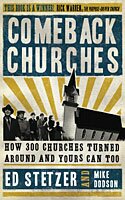|
 Printer-friendly Version Printer-friendly Version  E-mail Story E-mail Story
'Comeback churches' refuse to die; seek new life
June 04, 2007
By Shawn Hendricks
 |
|
|
The few remaining people at Terrace Heights Baptist Church in Yakima, Wash., didn't want their church to die.
After attendance had dwindled down to a handful of members, they feared the church would soon shut its doors for good. Something had to change fast.
Terrace Heights is one of many churches in the United States that started out strong, stopped growing and then fell into a period of decline. Currently, 70 percent of Southern Baptist churches have either leveled off in growth or are declining.
In the new book, "Comeback Churches: How 300 Churches Turned Around and Yours Can, Too," authors Ed Stetzer and Mike Dodson researched 300 churches among 10 denominations around the country. They mapped out a detailed approach to restoring "plateaued" or declining congregations. The book is published by B&H Publishing Group, the publishing division of LifeWay Christian Resources.
According to Leadership Journal, which the authors cite in the book, 340,000 churches are in need of church revitalization.
"Over time, most churches plateau, and most eventually decline," Stetzer writes. "Patterns and traditions that once seemed special eventually lose their meaning ... become more concerned about a well-used policy manual than a well-used baptistery."
For Terrace Heights, realizing there was a problem was the first step.
The second step involved being more upfront about the church's vision and direction. The congregation toughened their membership requirements by unveiling a new member's course and a yearlong new members "boot camp."
"They were desperate for anything that might bring life," Terrace Heights pastor Rob Morris said. "We know it is working because we have seen very few people leave or stop coming to the church."
Having the courage to admit mistakes and take action is where church revitalization begins, the authors say.
"Business as usual will continue to produce the same slow or no-growth environment that plagues the large majority of churches," Stetzer and Dodson write. "The church will need to have an honest evaluation of their current condition, get the church working together for a common solution, and determine what to do together."
Stetzer, who June 1 will became director of LifeWay Research, has authored several books and is currently co-pastor of Lake Ridge Church near Atlanta. Dodson has served as a pastor and church planter strategist for more than 10 years.
Many struggling churches are focusing too heavily on the wrong things, such as worship and preaching styles, they say.
"The wrong question is whether your church is 'traditional' or 'contemporary' and which is better," the authors add. "The real issue is whether your church is biblically faithful, acting as the presence of Christ in the community at large, able to relate Christ to people in culture, and is on mission."
Lack of outreach is another factor of church attendance stagnation or decline authors identified. The authors contend this is more of a "heart" issue than one of strategy and style.
"Most Christians don't like lost people," Stetzer and Dodson write. "We wish it were not so, but, it is. Lost people don't think like us; they often don't vote like us; they influence our kids ... they are not our people." (BP)
|






